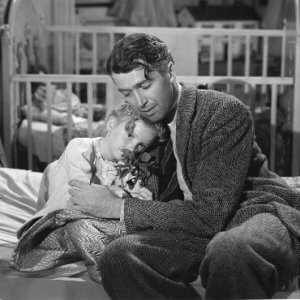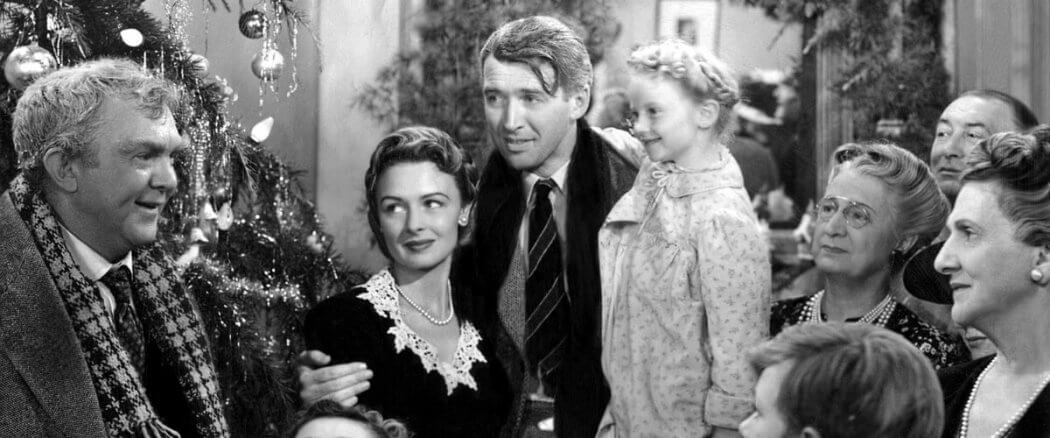If you’re looking to gratify a sense of nostalgia, or if you want to be stimulated by a film that has a good old-fashioned love story, or if you have an itch to see someone stick it to the man and watch an underdog fight the powers-that-be, or if you have a soft spot for down-on-your-luck angels who take an unorthodox approach to helping humankind, or if you’re looking to settle in to watch a film that is one of the finest experiences of effortless story-telling in all of cinema, or if you simply have a weakness for a happy, hopeful, and heart-warming ending, then at some point you may have found yourself indulging in the pleasure of watching It’s a Wonderful Life. I know I have. And I know that a lot of you have, too. Another thing I know is that there are a lot of good reasons that Frank Capra’s film has become one of the most beloved of all-time, despite having not been well-received when it was released way back in the 1940s. Now, nearly 70 years later, the story of George Bailey has a secure place in the canon of American culture.
It’s a Wonderful Parable
I have a feeling that if Jesus told parables using film, the story of George Baily might just be the type of thing that he would come up with. I say that because the power of parable, like the power of It’s a Wonderful Life, seems to come from its ability to connect with the common person. Of course, it could be argued that every story seeks to do this, and any good story succeeds, but I think that Jesus, like Capra, went one step further by tapping into the better angels of our nature. Jesus, by and large, spoke to the good that was common to the common person. Yes, Jesus talked about the bad seeds, and he had his share of run-ins with the Pharisees and Sadducees, just like Capra had his Potter, but what I mean by tapping into the common goodness is that Jesus’ parables seemed most at home in the hearts and minds of people seeking to do simple good, people who were not looking for something grand or complicated, people inclined to receive truth that was simple enough to accomplish substantial change.
 In It’s a Wonderful Life, Frank Capra deliberately explored the American Everyman. It was a recurring theme in all of his work. There’s a reflective quote by Capra in his later life that I found quite intriguing. In this quote, Capra is clearly miffed. It’s the 1970s, and he’s mad at the hippies and counter-culturalists, and it’s not hard to detect bitterness directed toward Hollywood, probably stemming in large part to the fact that his later works weren’t well-received. Nonetheless, there’s something profound about this quote, something poetic even, especially for those of us who love to root for George Bailey every Christmas, holiday after holiday, decade after decade, all the while knowing how the story will end.
In It’s a Wonderful Life, Frank Capra deliberately explored the American Everyman. It was a recurring theme in all of his work. There’s a reflective quote by Capra in his later life that I found quite intriguing. In this quote, Capra is clearly miffed. It’s the 1970s, and he’s mad at the hippies and counter-culturalists, and it’s not hard to detect bitterness directed toward Hollywood, probably stemming in large part to the fact that his later works weren’t well-received. Nonetheless, there’s something profound about this quote, something poetic even, especially for those of us who love to root for George Bailey every Christmas, holiday after holiday, decade after decade, all the while knowing how the story will end.
“Forgotten among the hue-and criers were the hard-working stiffs that came home too tired to shout or demonstrate in streets … and prayed they’d have enough left over to keep their kids in college, despite their knowing that some were pot-smoking, parasitic parent-haters. Who would make films about, and for, these uncomplaining, unsqueaky wheels that greased the squeaky? Not me. My “one man, one film” Hollywood had ceased to exist. Actors had sliced it up into capital gains. And yet – mankind needed dramatizations of the truth that man is essentially good, a living atom of divinity; that compassion for others, friend or foe, is the noblest of all virtues. Films must be made to say these things, to counteract the violence and the meanness, to buy time to demobilize the hatreds…” (from Capra’s 1971 autobiography, quote take from Wikipedia, November, 2015)
It’s a Wonderful Fight
I can forgive Capra for being a Republican. He probably just had an unhealthy hatred for hippies. I can forgive this too, because I think that Capra is on to something. He did, after all, make the film Mr. Smith Goes to Washington, also starring Jimmy Stewart, that pitted one simple country bumpkin against the powers of crony capitalism. I like to think that Capra was a bit of an old school progressive on that count, ala Teddy Roosevelt, a point that seems completely lost in the fray of today’s Republican politics.
Capra is on to something because George Bailey was on to something. The life of George Bailey is the life of the American Everyman, the life well-lived, the life that will make a nation great, the life that most demonstrates the “living atom of divinity” within us all.
We need people to fight the Potters of the world, the machines of greed and destruction, to “counteract the violence and the meanness,” as Capra would say, and “to buy time to demobilize the hatreds.” When people fail to do good, however simple this good may be, then the world becomes a hard, cold place. It becomes Pottersville.
Here at home, but most especially on a global scale, the world has become a harder, colder place, a Pottersville for the majority of the world’s citizens. We seem to be at the tail end of decades of victories by the powerful Potters of global commerce. We need a new system, yes, but before that, we need more ordinary people to give a damn and pick up the George Bailey mantel.
It’s a Wonderful Choice
George Bailey felt the struggle, though. He had a vision for his life. “I’m shakin’ the dust of this crummy little town off my feet,” George said, “and I’m gonna see the world! Italy, Greece, the Parthenon, the Colosseum. Then, I’m comin’ back here to go to college and see what they know. And then I’m gonna build things. I’m gonna build airfields, I’m gonna build skyscrapers a hundred stories high, I’m gonna build bridges a mile long…” George was conflicted, torn between indulging his desire to live the American Dream and his sense of duty and honor. To fight the powerful Potters requires sacrifice. The good might be simple, but it’s never easy.
 Capra’s on to something, not just for his vision of the good, but because we need “dramatizations of the truth that man is essentially good.” I don’t take from this statement of his any deep theology on the nature of human beings. Instead, I think that what the story of George Bailey stirs in us is similar to what Jesus tapped into when he told parables — it’s the core part of us that resonates with what is right, and it inspires us to sacrifice. Whether we are inherently good or evil is not a question I’m interested in, and I don’t think that Jesus was either. What I’m interested in exploring is what Jesus and Capra did so well. I’m interested in the way stories can stir that “living atom of divinity” within us, turning our perspectives from ourselves outward toward others. This sacred within us all is simple, and it’s a pearl of great price, but it’s so easy to lose touch with.
Capra’s on to something, not just for his vision of the good, but because we need “dramatizations of the truth that man is essentially good.” I don’t take from this statement of his any deep theology on the nature of human beings. Instead, I think that what the story of George Bailey stirs in us is similar to what Jesus tapped into when he told parables — it’s the core part of us that resonates with what is right, and it inspires us to sacrifice. Whether we are inherently good or evil is not a question I’m interested in, and I don’t think that Jesus was either. What I’m interested in exploring is what Jesus and Capra did so well. I’m interested in the way stories can stir that “living atom of divinity” within us, turning our perspectives from ourselves outward toward others. This sacred within us all is simple, and it’s a pearl of great price, but it’s so easy to lose touch with.
We need to find ways to create new stories and to retell the old stories in new and compelling ways, to speak to the marrow of human experience that we all share. The stories we tell are not mere yarns that we spin, tall tales that we tell. The stories that Jesus told emerged from the depth of a life of struggle and sacrifice, and that’s what made his parables and life so compelling. Our own lives, stories in the making, are no different, and the choices we make will determine the direction of our world, whether it be the cold, hard place that it has become or whether it will become something more like a community, a place of goodness and warmth.





